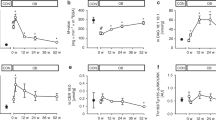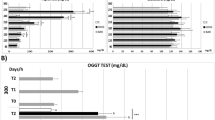Abstract
Objective:
Insulin resistance is a strong biological marker of both obesity and type 2 diabetes. Abnormal fat deposition within skeletal muscle has been identified as a mechanism of obesity-associated insulin resistance. Biliopancreatic diversion (BPD), inducing a massive lipid malabsorption, leads to a reversion of type 2 diabetes. To elucidate the mechanisms of diabetes reversibility, the expression of genes involved in glucose and free fatty acids (FFAs) metabolism was investigated in skeletal muscle biopsies from obese, type 2 diabetic subjects. Peripheral insulin sensitivity and insulin secretion was also measured.
Subjects:
Eight Caucasian obese diabetic patients (BMI 52.1±1.85 kg/m2) were studied before and 3 years after BPD.
Measurements:
The mRNA levels were estimated by quantitative real-time reverse transcription polymerase chain reaction (RT-PCR), insulin sensitivity by the euglycemic–hyperinsulinemic clamp and insulin secretion using a model describing the relationship between insulin secretion and glucose concentration.
Results:
Whole-body glucose uptake (M), normalized by fat-free mass, significantly increased in post-obese subjects (P<0.0001). Total insulin output decreased (P<0.05) in association with a significant improvement of β-cells glucose sensitivity (P<0.05). mRNA levels of FABP3 (P<0.05), FACL (P<0.05), ACC2 (P<0.05), HKII (P<0.05) and PDK4 (P<0.05) were significantly decreased, while SREBP1c mRNA increased (P<0.05) after BPD.
Conclusion:
Reversibility of type 2 diabetes after BPD is dependent on the improvement of skeletal muscle insulin sensitivity, mediated by changes in the expression of genes regulating glucose and fatty acid metabolism in response to nutrient availability.
This is a preview of subscription content, access via your institution
Access options
Subscribe to this journal
Receive 12 print issues and online access
$259.00 per year
only $21.58 per issue
Buy this article
- Purchase on Springer Link
- Instant access to full article PDF
Prices may be subject to local taxes which are calculated during checkout






Similar content being viewed by others
References
Colagiuri S, Borch-Johnsen K, Glumer C, Vistisen D . There really is an epidemic of type 2 diabetes. Diabetologia 2005; 48: 1459–1463.
World Health Organisation. Obesity: preventing and managing the global epidemic. Report of a WHO consultation 2000. WHO Technical Report Series.
McGarry JD . Banting lecture 2001: dysregulation of fatty acid metabolism in the etiology of type 2 diabetes. Diabetes 2002; 51: 7–18.
Bergman RN, Ader M . Free fatty acids and pathogenesis of type 2 diabetes mellitus. Trends Endocrinol Metab 2000; 11: 351–356.
Hwang JH, Pan JW, Heydari S, Hetherington HP, Stein DT . Regional differences in intramyocellular lipids in humans observed by in vivo1H-MR spectroscopic imaging. J Appl Physiol 2001; 90: 1267–1274.
Kelley DE, Goodpaster BH, Storlien L . Muscle triglyceride and insulin resistance. Annu Rev Nutr 2002; 22: 325–346.
Goodpaster BH, Theriault R, Watkins SC, Kelley DE . Intramuscular lipid content is increased in obesity and decreased by weight loss. Metabolism 2000; 49: 467–472.
Manco M, Mingrone G, Greco AV, Capristo E, Gniuli D, De Gaetano A et al. Insulin resistance directly correlates with increased saturated fatty acids in skeletal muscle triglycerides. Metabolism 2000; 49: 220–224.
Goodpaster BH, Kelley DE, Wing RR, Meier A, Thaete FL . Effects of weight loss on regional fat distribution and insulin sensitivity in obesity. Diabetes 1999; 48: 839–847.
Greco AV, Mingrone G, Giancaterini A, Manco M, Morroni M, Cinti S et al. Insulin resistance in morbid obesity: reversal with intramyocellular fat depletion. Diabetes 2002; 51: 144–151.
Storlien L, Oakes ND, Kelley DE . Metabolic flexibility. Proc Nutr Soc 2004; 63: 363–368.
Felber JP, Ferrannini E, Golay A, Meye HU, Theibaud D, Curchod B et al. Role of lipid oxidation in the pathogenesis of insulin resistance of obesity and type II diabetes. Diabetes 1987; 36: 1341–1350.
Mingrone G, Manco M, Calvani M, Castagneto M, Naon D, Zorzano A . Could the low level of expression of the gene encoding skeletal muscle mitofusin-2 account for the metabolic inflexibility of obesity? Diabetologia 2005; 48: 2108–2114.
Kelley DE, He J, Menshikova EV, Ritov VB . Dysfunction of mitochondria in human skeletal muscle in type 2 diabetes. Diabetes 2002; 51: 2944–2950.
Guidone C, Manco M, Nanni G, Valera-Mora E, Iaconelli A, Gniuli D et al. Mechanisms of recovery from type 2 diabetes mellitus after malabsorption bariatric surgery. Diabetes 2006; 55: 2025–2031.
Mari A, Manco M, Guidone C, Nanni G, Castagneto M, Mingrone G et al. Restoration of normal glucose tolerance in severely obese patients after bilio-pancreatic diversion: role of insulin sensitivity and beta cell function. Diabetologia 2006; 49: 2136–2143.
Scopinaro N, Gianetta E, Civalleri D, Bonalumi U, Bachi V . Biliopancreatic bypass for obesity: II. Initial experience in man. Br J Surg 1979; 66: 619–620.
Moore FD, Olesen KH, McMurrey JD, Parker HV, Ball MR, Boyden CM . The Body Cell Mass and Its Supporting Environment 1963. Philadelphia, PA, USA: WB Saunders.
Culebras JM, Moore FD . Total body water and the exchangeable hydrogen: I. Theoretical calculations of nonaqueous exchangeable hydrogen in men. Am J Physiol 1977; 232: R54–R59.
Heymsfield SB, Lichtman S, Baumgartner RN, Wang J, Kamen Y, Aliprantis A et al. Body composition of humans: comparison of two improved four-compartment models that differ in expense, technical complexity, and radiation exposure. Am J Clin Nutr 1990; 52: 52–58.
DeFronzo RA, Tobin JD, Andres R . Glucose clamp technique: a model for quantifying insulin secretion and resistance. Am J Physiol 1979; 237: E214–E223.
Van Cauter E, Blackman JD, Roland D, Spire JP, Refetoff S, Polonsky KS . Modulation of glucose regulation and insulin secretion by circadian rhythmicity and sleep. J Clin Invest 1991; 88: 934–942.
Chomczynski P, Sacchi N . Single-step method of RNA isolation by acid guanidinium thiocyanate–phenol–chloroform extraction. Anal Biochem 1987; 162: 156–159.
Rome S, Clement K, Rabasa-Lhoret R, Loizon E, Poitou C, Barsh GS et al. Microarray profiling of human skeletal muscle reveals that insulin regulates approximately 800 genes during a hyperinsulinemic clamp. J Biol Chem 2003; 278: 18063–18068.
Mingrone G, Rosa G, Greco AV, Manco M, Vega N, Nanni G et al. Intramyocitic lipid accumulation and SREBP-1c expression are related to insulin resistance and cardiovascular risk in morbid obesity. Atherosclerosis 2003; 170: 151–161.
Mingrone G, Rosa G, Greco AV, Manco M, Vega N, Hesselink MK et al. Decreased uncoupling protein expression and intramyocytic triglyceride depletion in formerly obese subjects. Obes Res 2003; 11: 632–640.
Rosa G, Manco M, Vega N, Greco AV, Greco AV, Castagneto M et al. Decreased muscle acetyl-coenzyme A carboxylase 2 mRNA and insulin resistance in formerly obese subjects. Obes Res 2003; 11: 1306–1312.
Calvani M, Scarfone A, Granato L, Valera Mora E, Nanni G, Castagneto M et al. Restoration of adiponectin pulsatility in severely obese subjects after weight loss. Diabetes 2004; 53: 939–947.
De Fronzo RA, Jacot E, Jequier E, Maeder E, Wahren J, Felber JP . The effect of insulin on the disposal of intravenous glucose: results from indirect calorimetry and hepatic and femoral venous catheterization. Diabetes 1981; 130: 1000–10075.
Debard C, Laville M, Berbe V, Loizon E, Guillet C, Morio-Liondore B et al. Expression of key genes of fatty acid oxidation, including adiponectin receptors, in skeletal muscle of Type 2 diabetic patients. Diabetes 2004; 97: 917–925.
Storlien L, Jenkins A, Chisholm D, Pascoe W, Khouri S, Kraegen E . Influence of dietary fat composition on development of insulin resistance in rats: relationship to muscle triglyceride and w3 fatty acids in muscle phospholipids. Diabetes 1991; 40: 280–289.
Pagliasotti MJ, Pan D, Prach P, Koppenhalfer T, Storlien L, Hill JO . Tissue oxidative capacity, fuel stores and skeletal muscle fatty acid composition in obesity-prone and obesity-resistant rats. Obes Res 1995; 3: 459–464.
Foufelle F, Ferre P . New perspectives in the regulation of hepatic glycolytic and lipogenic genes by insulin and glucose: a role for the transcription factor sterol regulatory element binding protein-1c. Biochem J 2002; 366: 377–391.
Osborne TF . Sterol regulatory element-binding proteins (SREBPs): key regulators of nutritional homeostasis and insulin action. J Biol Chem 2000; 275: 32379–32382.
Sewter C, Berger D, Considine RV, Medina G, Rochford J, Ciaraldi T et al. Human obesity and type 2 diabetes are associated with alterations in SREBP1 isoform expression that are reproduced ex vivo by tumor necrosis factor-alpha. Diabetes 2002; 51: 1035–1041.
Weiler U, Riesinger I, Knoll G, Brdiczka D . The regulation of mitochondrial-bound hexokinases in the liver. Biochem Med 1985; 33: 223–235.
Vogt C, Yki-Jarvinen H, Iozzo P, Pipek R, Pendergrass M, Koval J et al. Effects of insulin on subcellular localization of hexokinase II in human skeletal muscle in vivo. J Clin Endocrinol Metab 1985; 83: 230–234.
Heikkinen S, Pietila M, Halmekyto M, Suppola S, Pirinen E, Deeb SS et al. Hexokinase II-deficient mice. Prenatal death of homozygotes without disturbances in glucose tolerance in heterozygotes. J Biol Chem 1999; 274: 22517–22523.
Cusi KJ, Pratipanawatr T, Koval J, Printz R, Ardehali H, Granner DK et al. Exercise increases hexokinase II mRNA, but not activity in obesity and type 2 diabetes. Metabolism 2001; 50: 602–606.
Randle PJ, Priestman DA, Mistry SC, Halsall A . Glucose fatty acid interactions and the regulation of glucose disposal. J Cell Biochem 1994; 55: 1–11.
Randle PJ, Priestman DA, Mistry SC, Halsall A . Mechanism modifying glucose oxidation in diabetes mellitus. Diabetologia 1994; 37: S155–S161.
Fuller SJ, Randle PJ . Reversible phosphorylation of pyruvate dehydrogenase in rat skeletal muscle mitochondria: effects of starvation and diabetes. Biochem J 1984; 219: 635–646.
Batenburg JJ, Olson MS . Regulation of pyruvate dehydrogenase by fatty acid in isolated rat liver mitochondria. J Biol Chem 1976; 251: 1364–1370.
Rosa G, Di Rocco P, Manco M, Greco AV, Castagneto M, Vidal H et al. Reduced PDK4 expression associated with increase insulin sensitivity in postobese patients. Obes Res 2003; 11: 167–169.
Yamauchi T, Kamon J, Minokoshi Y, Ito Y, Waki H, Uchida S et al. Adiponectin stimulates glucose utilization and fatty-acid oxidation by activating AMP-activated protein kinase. Nat Med 2002; 8: 1288–1295.
Minokoshi Y, Kim YB, Peroni OD, Fryer LG, Muller C, Carling D et al. Leptin stimulates fatty-acid oxidation by activating AMP-activated protein kinase. Nature 2002; 415: 339–343.
Mingrone G, Manco M, Granato L, Calvani M, Scarfone A, Mora EV et al. Leptin pulsatility in formerly obese women. FASEB J 2005; 19: 1380–1382.
Clarke SD, Gasperikova D, Nelson C, Lapillonne A, Heird WC . Fatty acid regulation of gene expression: a genomic explanation for the benefits of the mediterranean diet. Ann NY Acad Sci 2002; 967: 283–298.
Fernandez-Real JM, Ricart W . Insulin resistance and chronic cardiovascular inflammatory syndrome. Endocr Rev 2003; 24: 278–301.
Author information
Authors and Affiliations
Corresponding author
Rights and permissions
About this article
Cite this article
Rosa, G., Mingrone, G., Manco, M. et al. Molecular mechanisms of diabetes reversibility after bariatric surgery. Int J Obes 31, 1429–1436 (2007). https://doi.org/10.1038/sj.ijo.0803630
Received:
Revised:
Accepted:
Published:
Issue Date:
DOI: https://doi.org/10.1038/sj.ijo.0803630
Keywords
This article is cited by
-
Medium-Term Results of Combined Laparoscopic Sleeve Gastrectomy and Modified Jejuno-Ileal Bypass in Bariatric Surgery
Obesity Surgery (2016)
-
Comparison of Metabolic Effects of Surgical-Induced Massive Weight Loss in Patients with Long-Term Remission Versus Non-remission of Type 2 Diabetes
Obesity Surgery (2012)
-
Feasibility of a Supervised Inpatient Low-Calorie Diet Program for Massive Weight Loss Prior to RYGB in Superobese Patients
Obesity Surgery (2010)



